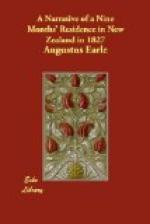The top of this hill was level and square, and was capable of containing several hundred warriors. It was cut into slopes all round, and fortified by stockades in every direction, which rendered it impregnable. The natives assured me its strength had been often tried. The famous warrior Hongi had attacked it several times, but had always been defeated with great loss. After inspecting this fortification, which excited our admiration, we proceeded through the village at the bottom of the hill. Nearly the whole of the inhabitants were out working in the fields. We entered several of their habitations, and found all their property exposed and unguarded. Even their muskets and powder, which they prize above everything, were open to our inspection, so little idea of robbery have they amongst themselves. But as there are many hogs and dogs roaming at large through their villages, they are very careful to fence their dwellings round with wicker work, to preserve them from the depredations of these animals; and as the houses are extremely low, they have very much the appearance of bird cages or rabbit hutches. Their storehouses are generally placed upon poles, a few feet from the ground, and tabooed or consecrated. Great taste and ingenuity are displayed in carving and ornamenting these depositories. I made drawings from several of them, which were entirely covered with carving; and some good attempts at groups of figures, as large as life, plainly showed the dawning of the art of sculpture amongst them. Many of the attempts of the New Zealanders in that art are quite as good, if not better, than various specimens I have seen of the first efforts of the early Egyptians.




